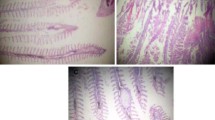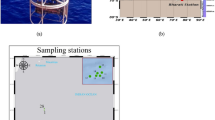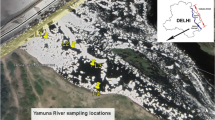Abstract
Sodium dodecyl sulfate (SDS) is one of the most commonly used detergent, which exhibits excellent biocidal activity against various bacteria and fungi. It is commonly employed in many detergent formulations and is employed for disinfection purposes. It is shown to be toxic to fishes, aquatic animals and is also inhibitory to microbes and cyanobacteria. We had isolated a strain belonging to Pseudomonas aeruginosa N1, from a detergent contaminated pond situated in Varanasi city India, which was able to degrade and metabolize SDS as a source of carbon. In the present investigation, we have studied chemotactic response of this strain towards SDS. The results clearly indicate that this strain showed chemotactic response towards SDS. The nature of chemotaxis was found to be metabolism dependent as glucose grown cells showed a delayed chemotactic response towards SDS. This is first study that reported chemotaxis response for P. aeruginosa towards anionic detergent SDS.

Similar content being viewed by others

Abbreviations
- SDS:
-
Sodium dodecyl sulfate
- PBM:
-
Phosphate buffered medium
- TTC:
-
2,3,5-Triphenyl tetrazolium chloride
- NACs:
-
Nitro aromatic compounds
- 2,4-D:
-
2,4-Dichloro phenoxy acetic acid
References
Pandey G, Jain RK (2002) Bacterial chemotaxis toward environmental pollutants: role in bioremediation. Appl Environ Microbiol 68:5789–5795
Gordillo F, Chávez FP, Jerez CA (2007) Motility and chemotaxis of Pseudomonas sp. B4 towards polychlorobiphenyls and chlorobenzoates. FEMS Microbiol Ecol 60:322–328
Liu H, Wang SJ, Zhou NY (2005) A new isolate of Pseudomonas stutzeri that degrades 2-chloronitrobenzene. Biotechnol Lett 27:275–278
Ohtsubo Y, Kudo T, Tsuda M, Nagata Y (2004) Strategies for bioremediation of polychlorinated biphenyls. Appl Microbiol Biotechnol 65:250–258
Paul D, Singh R, Jain RK (2006) Chemotaxis of Ralstonia sp. SJ98 towards p-nitrophenol in soil. Environ Microbiol 8:1797–1804
Krell T, Lacal J, Reyes-Darias JA, Jimenez-Sanchez C, Sungthong R, Ortega-Calvo JJ (2012) Bioavailability of pollutants and chemotaxis. Curr Opin Biotechnol 24:451–456
Parales RE (2004) Nitrobenzoates and aminobenzoates are chemoattractants for Pseudomonas strains. Appl Environ Microbiol 70:285–292
Pandey J, Chauhan A, Jain RK (2009) Integrative approaches for assessing the ecological sustainability of in situ bioremediation. FEMS Microbiol Rev 33:324–375
Parales RE, Harwood CS (2002) Bacterial chemotaxis to pollutants and plant-derived aromatic molecules. Curr Opin Microbiol 5:266–273
Ferrández A, Hawkins AC, Summerfield DT, Harwood CS (2002) Cluster II che genes from Pseudomonas aeruginosa are required for an optimal chemotactic response. J Bacteriol 184:4374–4383
Egbert MD, Barandiaran XE, Di Paolo EA (2010) A minimal model of metabolism-based chemotaxis. PLoS Comput Biol 6:e1001004
Hossein F, Malekzadeh F, Amir mozafari N, Ghaemi N (2007) Biodegradation of anionic surfactants by isolated bacteria from activated sludge. Int J Environ Sci Tech 4:127–132
Lima TM, Procópio LC, Brandão FD, Carvalho AM, Tótola MR, Borges AC (2011) Biodegradability of bacterial surfactants. Biodegradation 22:585–592
Rosety M, Ordonez FJ, Rosety RM, Rosety JM, Rosety I, Carrasco C, Ribelles A (2001) Comparative study of the acute toxicity of anionic surfactants alkyl benzene sulfonate (ABS) and sodium dodecyl sulfate (SDS) on gilthead, Sparus aurata L., eggs. Histol Histopathol 4:1091–1095
Rebello S, Asok AK, Joseph SV, Joseph BV, Jose L, Mundayoor S, Jisha MS (2013) Bioconversion of sodium dodecyl sulphate to rhamnolipid by Pseudomonas aeruginosa: a novel and cost-effective production strategy. Appl Biochem Biotechnol 169:418–430
Bhagwat AA, Leow YN, Liu L, Dharne M, Kannan P (2012) Role of anionic charges of periplasmic glucans of Shigella flexneri in overcoming detergent stress. Foodborne Pathog Dis 9:632–637
Cserháti T, Forgács E, Oros G (2002) Biological activity and environmental impact of anionic surfactants. Environ Int 28:337–348
Ying GG (2006) Fate, behavior and effects of surfactants and their degradation products in the environment. Environ Int 32:417–431
Chaturvedi V, Kumar A (2011) Diversity of culturable sodium dodecy sulfate (SDS) degrading bacteria isolated from detergent contaminated ponds situated in Varanasi city India. Int Biodeter Biodegr 65:961–971
Sondi I, Salopek-Sondi B (2004) Silver nanoparticles as antimicrobial agent: a case study on E. coli as a model for gram-negative bacteria. J Colloid Interf Sci 275:177–182
Ellis AJ, Hales SG, Ur-Rehman NG, White GF (2002) Novel alkyl sulfatases required for biodegradation of the branched primary alkyl sulfate surfactant 2-butyloctyl sulfate. Appl Environ Microbiol 68:31–36
Pandey J, Sharma NK, Khan F, Ghosh A, Oakeshott JG, Jain RK, Pandey G (2012) Chemotaxis of Burkholderia sp. Strain SJ98 towards chloronitroaromatic compounds that it can metabolise. BMC Microbiol 12:19
Abboud MM, Khleifat KM, Batarseh M, Tarawneh KA, Al-Mustafa A, Al-Madadhah M (2007) Different optimization conditions required for enhancing the biodegradation of linear alkylbenzenesulfonate and sodium dodecyl sulfate surfactants by novel consortium of Acinetobacter calcoaceticus and Pantoea agglomerans. Enz Microbial Tech 41:432–439
Arora PK, Sasikala C, Ramana CV (2012) Degradation of chlorinated nitroaromatic compounds. Appl Microbiol Biotechnol 93:2265–2277
Hawkins AC, Harwood CS (2002) Chemotaxis of Ralstonia eutropha JMP123(pJP4) to the herbicide 2,4-dichlorophenoxyacetate. Appl Environ Microbiol 68:968–972
Alexandre G, Greer-Phillips S, Zhulin IB (2004) Ecological role of energy taxis in microorganisms. FEMS Microbiol Rev 28:113–126
Lamanna AC, Ordal GW, Kiessling LL (2005) Large increases in attractant concentration disrupt the polar localization of bacterial chemoreceptors. Mol Microbiol 57:774–785
Szurmant H, Ordal GW (2004) Diversity in chemotaxis mechanisms among the bacteria and archaea. Microbiol Mol Biol Rev 68:301–319
Baker MD, Wolanin PM, Stock JB (2006) Signal transduction in bacterial chemotaxis. BioEssays 28:9–22
Greer-Phillips SE, Alexandre G, Taylor BL, Zhulin IB (2003) Aer and Tsr guide Escherichia coli in spatial gradients of oxidizable substrates. Microbiology 149:2661–2667
Xie Z, Ulrich LE, Zhulin IB, Alexandre G (2010) PAS domain containing chemoreceptor couples dynamic changes in metabolism with chemotaxis. Proc Natl Acad Sci USA 107:2235–2240
Bibikov SI, Barnes LA, Gitin Y, Parkinson JS (2000) Domain organization and flavin adenine dinucleotide-binding determinants in the aerotaxis signal transducer Aer of Escherichia coli. Proc Natl Acad Sci USA 97:5830–5835
Acknowledgments
V.C. is grateful to Council for Scientific and Industrial Research (CSIR), New Delhi, India for the award of Junior Research Fellowship. This study was partly supported by a research grant sanctioned to A.K. by the Department of Biotechnology, Govt. of India, New Delhi (BT/PR1239/AGR./02/065/98).
Author information
Authors and Affiliations
Corresponding author
Electronic supplementary material
Below is the link to the electronic supplementary material.
12088_2013_426_MOESM1_ESM.tif
NATIVE PAGE Zymography of alkyl sulfatase of P. aeruginosa strain N1.Lane1. SDS grown cells, Lane 2. Glucose grown cells (TIFF 192 kb)
12088_2013_426_MOESM2_ESM.tif
Swarm Plate assay for chemotaxis. (A) Chemotaxis in presence of Glucose (Control), (B) Chemotaxis in presence of SDS. (TIFF 804 kb)
12088_2013_426_MOESM3_ESM.tif
Drop plate assay for bacterial chemotaxis. (A) chemotactic response towards Glucose,(B) SDS (10 mg), (C) SDS (30 mg), (D) response of SDS grown cells towards glucose, (E) response of glucose grown cells towards SDS, (F) response of SDS grown cells towards glucose and SDS, (G) response towards 1-dodecanol, (H) response of heat killed cells toward glucose(negative control), (I) response of heat killed cells towards SDS (negative control). (TIFF 2171 kb)
Rights and permissions
About this article
Cite this article
Chaturvedi, V., Kumar, A. Metabolism Dependent Chemotaxis of Pseudomonas aeruginosa N1 Towards Anionic Detergent Sodium Dodecyl Sulfate. Indian J Microbiol 54, 134–138 (2014). https://doi.org/10.1007/s12088-013-0426-8
Received:
Accepted:
Published:
Issue Date:
DOI: https://doi.org/10.1007/s12088-013-0426-8



